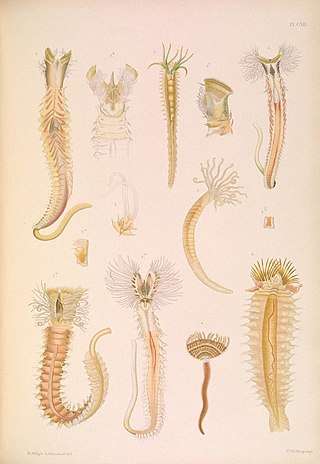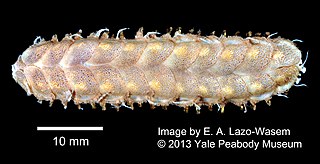
Nereis is a genus of polychaete worms in the family Nereididae. It comprises many species, most of which are marine. Nereis possess setae and parapodia for locomotion and gas exchange. They may have two types of setae, which are found on the parapodia. Acicular setae provide support. Locomotor setae are for crawling, and are the bristles that are visible on the exterior of the Polychaeta. They are cylindrical in shape, found not only in sandy areas, and they are adapted to burrow. They often cling to seagrass (posidonia) or other grass on rocks and sometimes gather in large groups.

Eunice is a genus in the polychaete family Eunicidae. Individuals grow to a length of between 0.5 and 300 cm. Their bodies have multiple segments. They have two eyes and five tentacles. They have well-developed sense organs and relatively large brains. Their color is dark purple-brown to red-brown with a white ring at the fourth segment. They are found in oceans and seas around the world. They have an evertible proboscis with distinctive mouthparts, some of which comprise two rows of maxilliary plates in a radula-like fashion.

Ampharetinae are a subfamily of terebellid "bristle worm". They are the largest subfamily of the Ampharetidae, of which they contain the great majority of the described genera.

Ampharete is a genus of polychaete annelid worms. They have a single, chevron-shaped row of teeth.

Phyllodoce is a genus of polychaete worms, which contains about 200 species. The prostomium bears eyes, two pairs of antennae and a pair of large retractile nuchal organs. The eversible proboscis is clearly divided into two parts.

Amphinomidae, also known as the fireworms, bristle worms or sea mice, are a family of marine polychaetes, many species of which bear chaetae mineralized with carbonate. The best-known amphinomids are the fireworms, which can cause great pain if their toxin-coated chaetae are touched or trodden on. Their relationship to other polychaete groups is somewhat poorly resolved.
Polyodontes is a genus of polychaete worms in the order Phyllodocida.

Lepidasthenia is a genus of marine Polychaete worms belonging to the family Polynoidae. Species of Lepidasthenia are found worldwide to depths of about 1200 m but are more common in shallower water.

Eunoe is a genus of marine annelids in the family Polynoidae. The genus includes 48 species which are found world-wide, mostly from depths of 50 m or more.

Acanthicolepis is a genus of marine annelids in the family Polynoidae. The genus was described in 1990 and includes two short-bodied species with up to 50 segments and which occur in the Mediterranean Sea and North-east Atlantic Ocean.

Lepidonotus is a genus of marine annelids in the family Polynoidae. The genus occurs globally and includes 80 species, usually found in shallow waters down to about 80 metres.
Austrolaenilla is a genus of marine annelids in the family Polynoidae. The genus includes 10 species which are known from depths of about 20 m to over 5000 m and from the Atlantic Ocean, Southern Ocean and Antarctic Ocean.
Bylgides is a genus of marine annelids in the family Polynoidae. The genus contains 9 species, all found in the Northern Hemisphere and from shallow inshore waters to depths of about 5000 m.
Eucranta is a genus of marine annelids in the family Polynoidae. The genus includes 5 species which are globally distributed from depths of about 40 to 600 m, mostly from high latitudes in the northern and southern hemispheres.
Robertianella is a genus of marine annelids in the family Polynoidae. There are 2 species of Robertianella which are known from depths of about 600 to 3000 m in the north-east Atlantic Ocean and the Mediterranean Sea.
Gattyana is a genus of marine annelids in the family Polynoidae. The genus includes 11 species, 9 of which occur in the northern hemisphere, the remaining two are from the Indian Ocean off Mozambique and the Southern Ocean off New Zealand. Species of Gattyana are known from shallow water down to depths of about 1200 m.
Hermadion is a genus of marine polychaete worms belonging to the family Polynoidae, the scaleworms. Hermadion contains a single species, Hermadion magalhaensi which is known from the South Atlantic, South Pacific and southern Indian Oceans at depths to about 110 m.
Subadyte is a genus of marine polychaete worms belonging to the family Polynoidae, the scaleworms. Eight species of Subadyte are recognised and the genus is known to occur widely in the world's oceans from the intertidal zone to depths of about 1200 m.
Lumbrineris is a genus of polychaetes belonging to the family Lumbrineridae.









